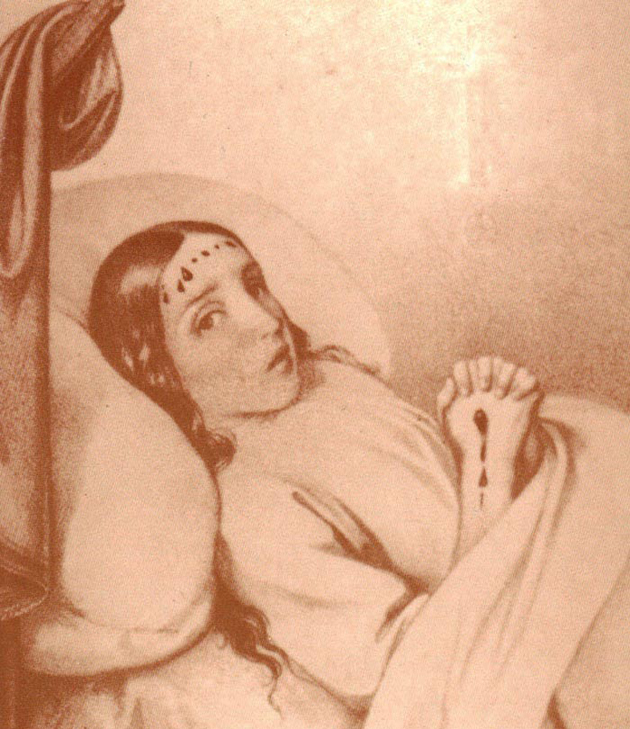
Maria Domenica Lazzeri

Above drawing is of Maria Domenica Lazzeri.
|
|||||
|
|||||
|
Following text is from [here].
Maria Domenica Lazzeri, Servant of God (1815-1848)
Maria Domenica Lazzeri, affectionately called by the local people "Blessed Meneghina”, was born March 16, 1815, in Capriana, Italy. She was the last of five children of Margaret and Bortolo Lazzeri, a miller by trade.
Early years
Maria Domenica lived a normal, peaceful childhood for her time and she graduated from the local village school. In her early teens, she devoted herself to work, prayer and helping the suffering, especially those affected by the epidemics that raged in that area in the 1820’s, and she helped her neighbors and those in nearby communities, especially in caring for the little children. During that period, she had a love for reading the lives of saints, most notably the writings of St Alphonsus Maria de Liguori and especially the accounts of the Passion and death of Jesus, in which she showed a marked preference.
The death of her father and her mysterious illness
In 1829, her father Bartolo dies of pneumonia. Maria Domenica was only thirteen. While it is normal for a child to suffer due to the loss of her father, but for Domenica the loss of her dad is something more: it marks the beginning of her incredible mystical journey. Since that fateful day, her health begins to deteriorate slowly. She is seized more and more by mysterious physical illnesses that are unexplainable, that slowly seem to weaken her. She also enters upon a more intense spiritual life. For over a year, when she was between the ages of 17 and 18 years, the entire region was infected by an influenza epidemic “the grippe". During this time, she spent countless hours helping with the care of those in nearby families.
Mysterious illness- Becomes completely bedridden
On August 15, 1833 (the feast of the Assumption of Mary) there began what Dr. Leonardo Cloch defined as “the long, painful illness of Maria Domenica Lazzeri.” It began with her staying in bed with what was believed to be the flu, along with her mother, but unlike the latter who would resume her normal activities within a week, Domenica was to remain bedridden for the rest of her life-from age 19 to 33- 14 years total- until her holy death in January, 1848.
Complete abstinence from food and drink- lives off the Eucharist alone
Soon afterwards, along with the strange and mysterious symptoms that plagued her, causing her to remain bedridden, her mother Margaret realizes that at night she seems not to sleep at all, and also she continually eats less and less. At Easter the following year (1834), her mother called Dr Cloch. He visits "the patient" and begins to keep meticulous records that today allow us to write this amazing story. Progressively, over the course of a year or so, through a special grace of God, she remarkably no longer required sleep, food or drink, except for Holy Communion, which she received while in her bed each Sunday. She lived solely off the Eucharist for 12 years. “For my flesh is real food and my blood is real drink” (John 6:55)
Receives the Stigmata
Along with complete abstinence from food, drink and sleep, comes the extraordinary mystical graces. In 1835 she received the grace of the bleeding Stigmata, which was soon followed by the mystical crown of thorns. She would receive the stigmata each Thursday evening into Friday afternoon, mystically suffering for the conversion of sinners in union with the Passion of Jesus. On one occasion the crown of thorns lesions in her head were counted and there were forty penetration wounds. At times, she would also bleed through wounds in various parts of her body, resembling the scourging. And so it is that through a special grace of God she becomes a true living image of Jesus Crucified.
Maria Domenica had numerous other mystical gifts, such as knowledge of certain future events, knowledge of languages never studied, and although she remained completely bedridden, she often "knew", what was being said far away, and through a special grace of God she could often hear the Blessed Mass being said in the neighboring Catholic Church, and incredably she was able to repeat the days sermon given by the local Pastor.
Her holy death
Like her Jesus, she was 33 years old, (the age of Christ) when she died on April 4, 1848. After fourteen years of illness, fasting and lack of sleep, having predicted both joyful and sad events, including the exact date of her death at the age of 33 years, “the Sorrows of Capriana” and "The living Crucifix " as she was known leaves this vale of tears. To the great joy and veneration of the faithful, her body remains exposed for seven days and, at the time of burial, her body is found to smell like a delicious bouquet of flowers.
The first official act for her cause was in 1943 followed by the official exhumation and recognition of the body in August, 1944, but the cause was then postponed because of the terrible events of World War II. Following fifty years of neglect and silence, the cause was taken up again in the early 1990's and on April 4, 1995 the Archbishop of Trento, Giovanni Maria Sartorio, celebrated in the Church the opening of the process of beatification of the Servant of God, Maria Domenica Lazzeri. Following a successful progression in the local Diocese of Trento, the cause moved to Rome to the responsible Vatican congregation in 2000. There are no pictures of her, but only an early portrait that depicts her in bed with the stigmata visible and her hands grouped and joined together, as if by nails.
|